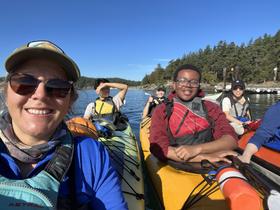International Students: Visas and More
If you live overseas and are considering sending your child to a boarding school in the United States, consider the following five admissions tips for international students.
- I assume you are not an American citizen or a green card holder, and English is not your first language.
- Many students from countries outside the United States want to attend American private schools.
- According to The Association of Boarding Schools, international students make up about 15% of the student population in American boarding schools.
Canva created this picture of an interview.

The I-20 Form
Be aware that not every boarding school is certified by the United States Immigration Service to accept foreign students. Why is that important?
- Always confirm that the school you are interested in is a Student and Exchange Visitor Program (SEVP) certified school.
- If the school is not SEVP-certified to accept international students, it cannot issue the I-20 form, which is the first step in applying for and obtaining a student visa from the U.S. Immigration Service.
- Once you receive the I-20 from the school you chose to attend, you will pay the I-901 Student and Exchange Visitor Information System (SEVIS) Fee.
- The Immigration Service will not allow your child to enter the United States as a student without the proper paperwork.
- If in doubt, ask the school if it can issue the I-20 form. Do not assume anything.
Pay Attention to The Deadlines
Applying for admission to an American boarding school requires staying organized and on top of deadlines throughout the admissions process.
- If you are not an American citizen, you will need a student visa to enter and remain in the United States to attend the boarding school that accepts you.
- Approval for a student visa takes time, typically 3-4 months. It also requires detailed documentation in support of your application.
- If you encounter difficulties, I recommend you consult an immigration attorney in your locality who specializes in United States immigration matters.
Here are some points to consider:
1. Complete and submit your school application.
You must follow the customary admissions process for each boarding school on your list to the letter.
- That includes submitting academic transcripts and teacher recommendations and scheduling an interview.
- U.S. schools will schedule in-person interviews with a visiting school representative whenever possible.
- Many schools also use Zoom or other video conferencing programs to interview parents and students.
- Be sure to register for the TOEFL school's standardized admissions test.
Once the school decides to accept you, it will give you a Form I-20, which allows you to apply for a student visa.
- The Form I-20 is the ImService Service's Certificate of Eligibility for Nonimmigrant (F-1) Student Status—For Academic and Language Students.
- It is part of the Student and Visitor Exchange Information System (SEVIS), which tracks information about all students coming to the United States.
- The next step is to pay the I-901 SEVIS fee.
- This fee must be paid before you have your visa interview at the American embassy or consulate in your country.
The Department of Homeland Security has detailed instructions for you to follow, both in written and video format.
2. Complete and submit your visa application.
The student visa application and interview is a detailed process requiring you to attend an interview with a U.S. Consular official.
- You will have to complete many U.S. Immigration Service forms. Check with your local U.S. Consulate for details on payment.
- Applying for visas takes a lot of time.
- Allow at least 60 days, and be prepared for the process to take much longer.
- Do not wait until the last minute to make your visa interview appointment.
- Most U.S. embassies in major urban areas overseas process thousands of visa applications daily.
- Make allowances for long waiting periods and the inevitable backlogs and delays.
3. Schedule your visa application interview.
The student applying for the visa must meet with a U.S. Consular official.
- That means spending time preparing for that interview.
- Know what questions will be asked.
- Understand how serious this part of the process is.
- Depending on where you live, it is often necessary to schedule visa interview appointments well in advance.
4. Have all documentation in order.
A passport valid for at least six months after entry is required.
- Academic documentation such as TOEFL test results, SSAT scores, and transcripts of your high school work will also be reviewed.
- Certified documentation of adequate financial resources is required.
- Suppose you do not have all your documentation when you arrive at the border.
- In that case, the Immigration Office may allow you to enter the United States for 30 days on a Form I-515A “Notice to Student or Exchange"e Visitor.”
- You will have 30 days to submit your documentation.
- If you fail to do so, you will have to leave the United States.
5. Pay attention to your visa restrictions.
Student visas have strict time limits. Adhere to those.
- Overstaying your visa by even one day can void it.
- In other words, you cannot decide to change anything about your visa terms without severe consequences unless the Immigration Service approves.
- As you probably have figured out if you have read this far, the American visa process is exact and detailed.
- I strongly recommend that you complete the process with the help of a knowledgeable immigration attorney in your area.
Suppose you forget to complete even one form or do not submit the correct documentation for your finances and citizenship.
- In that case, the U.S. consular official will deny the visa, and you will have to start the process over.
- Keep certified copies of all documentation in your possession for your peace of mind.
- Scan and save electronic copies of all documents to Google Drive or OneDrive so that you can access them anywhere quickly in case of an emergency.
Finally, impress your child with the need to follow the rules and procedures you lay out. Getting admitted into the United States is not a time for improvisation. Teach your child to call or text you with questions and concerns beforehand, not afterward.
Questions? Contact us on Facebook & Instagram, and YouTube. @boardingschoolreview
#boardingschools #internationalstudents #BoardingSchoolAdmissions #StudyAbroad #StudentVisas #AdmissionsTips
Editor's note: This article was assisted by AI tools, specifically Perplexity (Sonar), which provided suggestions and ideas during the research phase.












